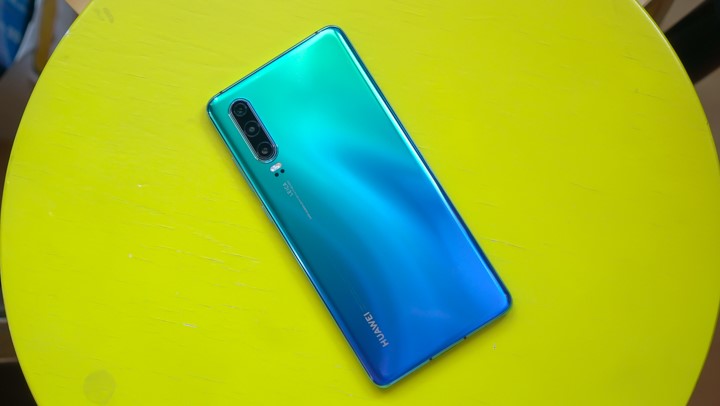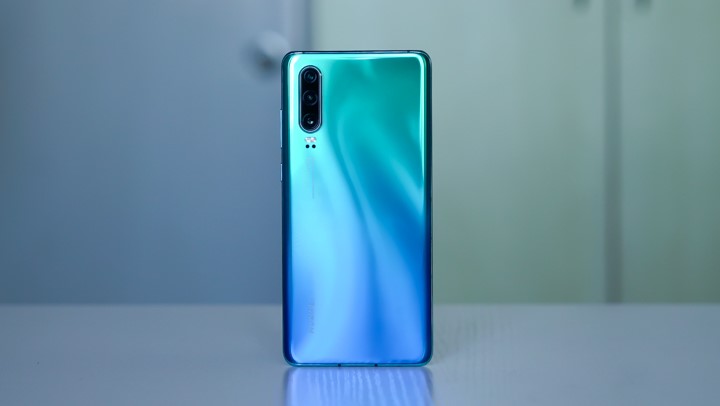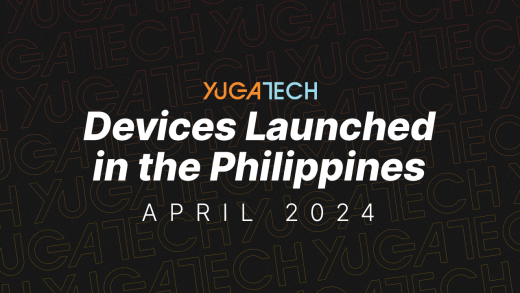Huawei is back at it again this year with innovations for its flagship P-series. Since its launch in Paris, the P30 and P30 Pro have been subject to very positive consumer response. Although most of the attention is at the more powerful Pro model, we got to give some attention to its little brother, the P30.

Table of Contents
Design and Construction
Design-wise, it’s pretty similar to last year’s Mate 20, minus the square rear camera layout. The rear cameras are vertically stacked like they were on the P20 and P20 Pro. So, we can say that it takes concepts from both Huawei’s 2018 flagship series.

Up front, we get a dewdrop notch for the 32MP front camera, slim bezels all around including the chin, and of course, for the display, we get a very nice 1080p OLED panel.

At the back, we have the triple rear camera stack, LED flash, and a pair of sensors used for autofocus. While I’m not a fan of protruding rear cameras since they result in wobbling on the table, I forgave it due to the capabilities these Leica-powered cameras bring to the table.

We don’t get a fingerprint scanner here since the P30 has adopted the optical in-display scanner from the Mate 20 Pro, and while we get a glass back panel that curves very nicely towards the sides.

But moving on to the sides, we have the volume and power buttons that feel amazing to press, and I love that they still kept the red accent on the power button. It makes the phone feel that much more unique.

Opposite these, we have a hybrid card tray for either two nanoSIM cards or one nanoSIM card and a NanoMemory card — which is again, another thing inherited from the Mate 20 Pro.

On the bottom, we have the loudspeaker, USB Type-C port, and a 3.5mm headphone jack, which the P30 Pro doesn’t have, so this is good news for wired headphone users.

Overall quality is great. It’s easy to grip and has a decent heft to it which is proof of its premium build. However, it has a lower IP53 rating unlike the P30 Pro with IP68. Still, it’s better to have some liquid and dust protection than none at all.
Like with most devices that use glass, the P30 is prone to smudges. I’m used to it though, but we’re glad that it comes with a clear case in the package, so I don’t have to wipe it now and then.
Display and Multimedia
Now checking out the screen, at 6.1-inches, the size is just right. Just like the P30 Pro and most other smartphones, our aspect ratio is at 19.5:9, though with its 2340 x 1080 resolution, it’s not the highest resolution display at this price point.

It’s still plenty sharp though, and since the panel is OLED, contrast is impressive as blacks are deep. And whether you’re in the standard or vivid display modes, colors are great though the latter is better for viewing content, especially on Netflix, since we also do get HDR10 support. In the grand scheme of things, it’s a great display, though it isn’t enough to rival something like the S10’s Dynamic AMOLED display.

For the speaker, while it’s loud, clear, and crisp, the bass is nonexistent. It’s also quite underwhelming that we don’t get a front-facing, or at the very least, stereo speakers, another notable flagship feature. And this isn’t just for the P30 as the Pro is guilty of this too. There’s a Dolby Atmos option that only works when you have headphones plugged in, but honestly, it doesn’t do a lot to help. Again, if we had stereo speakers, it might have been a different story.
Camera
Let’s check out the cameras. At the back, we have triple Leica cameras – 48MP main shooter, 16MP ultrawide shooter, and an 8MP telephoto shooter. What we’re missing here compared to the P30 Pro is the Time of Flight camera, and of course the periscopic telephoto system. Up front, our selfie camera is 32MP.

Overall quality is impressive for all three rear cameras as well as the front camera. Whether we’re in great lighting or low light, shots are very sharp, and we get a lot of qualities associated with Huawei’s post-processing. The images are very vivid and contrasty. I also find it great for taking portraits of people due to the warmer tones.
Portrait
Selfie
At the same time, if you’re more used to more neutral, more faithful photos like maybe if you’re coming from an iPhone or Pixel, then you may be put off by Huawei’s post-processing. But the images are very eye-catching nonetheless, and you probably don’t need to edit them as much. Moving on to night mode, this is where I am impressed. There’s just so much detail that gets captured, dynamic range is impressive, as well as noise reduction.
Main
And forget the fact that we don’t have the periscopic telephoto camera with up to 50x zoom, the P30’s camera hardware still provides a lot of flexibility. I am a huge advocate of ultrawide cameras over telephoto cameras since there are just so much more situations where they’re much more useful.
Ultrawide
However, while the P30’s telephoto camera isn’t as technologically advanced as the P30 Pro’s, we still get up to 30x digital zoom which is still crazy. The actual optical zoom only goes up to 5x, which is still pretty far all things considered. But I still stand by my point that for most people, the ultrawide camera is more useful than the telephoto cameras.
Zoom
For video, we can shoot up to 4K at 30FPS, and wow. Whether it’s in good lighting or at night, we get excellent quality, that nice saturated look, and stabilization is just rock solid.
OS, UI, and Apps
When it comes to software, the P30 runs on EMUI 9.1.0 based on Android 9 Pie. It’s a simple user interface that is easy to navigate. By default, all the apps are in multiple home screens, but you can also opt for the traditional app drawer style. You can also choose to use gesture-based navigation or the usual three-button navigation.

There are some apps pre-installed in the device, including a native Health app, Optimizer, Smart Remote, HiCare, and a Phone Clone app that is very useful when you want to transfer the contents and settings of your old phone to your new P30 (works flawlessly with Huawei phones). Other features include

Huawei has added a lot of productivity features and other software features that are both useful and practical. Among them are the App Twin (two instances of apps like FB Messenger, WhatsApp, etc.), option for Private Space as a second and completely separate working space from the Main Space, Huawei Share, Wireless Projection, and Smart Assistance for one-handed UI, motion control and voice control. I’m also glad that SwiftKey is the default input of the system.
I didn’t see a lot of pre-installed apps aside from the usual Google apps, which is good. I don’t mind installing a lot of apps or storing plenty of files as it has 128GB of storage. I can further expand it using an NM card, which can be a bit of a downer if you already have a microSD card on hand.
Performance and Benchmarks
For our internals, the configuration is pretty good. We get the same chipset as the P30 Pro, which is, of course, the Kirin 980 with Mali-G76 MP10 GPU. The retail unit coming to the Philippines will have 6GB of RAM and 128GB of storage, though our review unit here has 8GB of RAM, so this may inflate our benchmark scores a little bit.

• AnTuTu: 280,141
• GeekBench: 3,286 (Single Core), 9,578 (Multi-Core), 6,479 (RenderScript)
• 3DMark Slingshot Extreme: 3,495 (OpenGL ES 3.1) , 4, 358 (Vulkan)
• PCMark: 7,817 (Work 2.0)
• AndroBench: 904.29 MB/s (Read), 188.06 MB/s (Write)

Performance is superb, as expected, we already know how the Kirin 980 performs since this is the same chipset that the Mate 20 Pro has. Whether it’s heavy gaming, multitasking, productivity or whatnot, it’s a great phone for whatever task you may throw at it.
Connectivity and Battery Life
The P30 has plenty of connectivity features which includes 4G LTE, dual-SIM support, WiFi ac, Bluetooth 5.0, NFC, and support for a wide range of satellite-based navigation systems. Calls are loud and clear, mobile data is fast, and apps like Waze and Google Maps work well even in areas surrounded by buildings.

And providing juice to all of these is an above-average 3,650mAh battery, a slight upgrade over the P20’s 3,400mAh battery. It doesn’t last as long as the P30 Pro, but we can still get a lot of mileage out of it. PC Mark rated it at an underwhelming 7 hours and 25 minutes, but our video loop test got us 20 hours and 12 minutes. It’s decent, but you’ll need to charge it at the end of the day.

Wireless charging is absent which is one of the things I don’t like about this phone. I mean, it’s not exactly a deal breaker for most people, but come on – Samsung has wireless charging and even reverse wireless charging on all three S10 models. It’s also now a staple feature in flagship phones, so the P30 really should have had it.
In terms of wired charging, we get Huawei SuperCharge if you use the included charger and it’s excellent. From 20% to 100%, it only takes one hour. So yeah, we don’t have wireless charging, but we do have that.
Conclusion
Now when we take a step back and look at this phone as a whole, it’s an underdog of sorts. It’s not flashy. It doesn’t have the latest and most excellent features. But it has everything it needs to be considered a solid device that can hold up its end of the bargain for the money would-be consumers would be paying.

The P30 Pro is undoubtedly the star of the show this time around, while the P30 is more of a brooding, silent bad-ass. I think it deserves a little bit of the spotlight as well. While I am disappointed that the P30 lacks certain things like front-facing speakers, wireless charging, a higher resolution screen, etc. But at the same time, it’s also a whole 14,000 pesos cheaper than the P30 Pro at PHP36,990. And for everything you get, I think it’s a great deal.
Huawei P30 specs:
6.1-inch 19.5 FHD+ OLED display @ 2340 x 1080px, DCI-P3 HDR
HiSilicon Kirin 980 2.6GHz octa-core (Dual NPUs)
2 x Cortex-A76 Based 2.6 GHz+ 2 x Cortex-A76 Based 1.92 GHz + 4 x Cortex-A55 1.8 GHz
6GB RAM
128GB storage
Dual SIM card w/ NM card
Dual 4G VoLTE
40MP f/1.8 + 16MP f/2.2 ultra-wide-angle + 8MP f/2.4 (3X Optical Zoom, up to 5X Hybrid up to Zoom, 30X Digital Zoom) telephoto triple Leica rear cameras
up to ISO 204800, Professional Night Mode, Huawei AIS
Dual-View Video (wide-angle and close up view video recording)
32MP front camera
Wi-Fi 802.11a/b/g/n/ac (2.4GHz, 5GHz)
Bluetooth 5.0, BLE, SBC, AAC, aptX, aptX HD, LDAC, HWA Audio
GPS/ A-GPS/ Glonass/ BeiDou/ Galileo/ QZSS
NFC
USB 3.1 Type-C Gen 1
IP53 water and dust resistance
3.5mm audio port
Dolby Atmos speakers
In-screen fingerprint scanner (New generation)
EMUI 9.1 (Android 9 Pie)
3,650mAh battery with 40W SuperCharge technology
165g
Breathing Crystal, Amber Sunrise, Pearl White, Classic Black, Aurora
What we liked:
* Attractive design
* Premium build
* Great cameras
* Great performance
* SuperCharge tech
* 3.5mm audio jack
What we didn’t:
* No wireless charging
* No dual speaker setup
With additional input and editing by Louie Diangson.

























Hi! Does p30 also have LED Notifications near the front camera like the p30 lite?
It seems that it is confirmed that the official version on the market here is 8GB for P30, had asked this question to yugatech (no reply was given) regarding your insistent on the memory of P30 as 6GB even if Huawei already announced officially it is 8GB they are bringing in. Don’t know where you guys got your information, seems unreliable.
i suggest to you guys to use tripod while shooting at night for photos to post, b’cause its very shaky photos sample